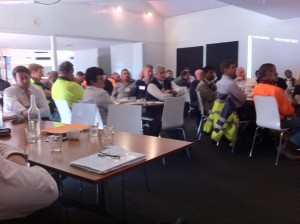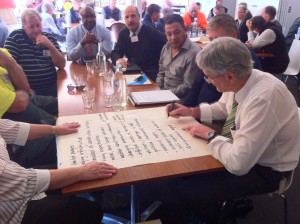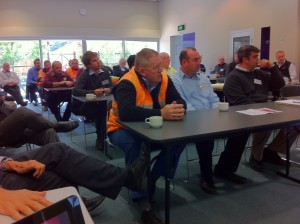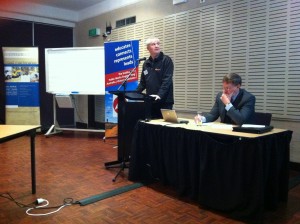Outcomes Regional Forums: Effective Road Maintenance on Limited Budgets
May 21, 2012 | No Comments | Events
Summary
IPWEAvic supported by VicRoads and AustStab undertook three regional group forums during May 2012, one in Western Victoria in Ballarat, one in Northern Victoria in Shepparton and one in Eastern Victoria in Warragul. The forums gave the opportunity to nearly 200 participants and over 30 organisations to discuss ideas, problems and find possible efficiencies in rural road maintenance. The format involved presentation by the VicRoads regional director, supported by a municipal view of the issue from the region , a case study and some practical tips for road maintenance in conjunction with a workshop on issues and suggestions for possible efficiencies that could be found in maintenance of our road networks.
Top 6 Points from Workshop Session
The workshop looked at the issues and solutions or efficiencies road authorities could use in maintaining the road network . The 6 top points that kept recurring throughout the three forums:
1. Drainage
Extreme changes in weather from drought to fire(stripping vegetation) to flood has highlighted the need to keep up maintenance of table drains, culverts and other rural road drainage to keep water from road pavements.
2. Heavy Vehicles
Increased use of the road networks by freight and construction traffic around large infrastructure projects such as desal plant in Gippsland and McCarthur windfarms in Western Victoria highlights the need to develop dedicated freight routes and importance of obtaining contributions during the planning stage of large infrastructure projects from developers of large infrastructure projects for road damage incurred during the construction phase of the project
3. Community Expectations
Community expectations are predominately around road safety, access and presentation of the roadside in rural areas. Communication with the community over levels of service available for the road network and why these levels have been set are paramount. Eg if the road surface is rough and funds are limited signage to the public to slow down may assist in safe travel through the hazard.
4. Appropriate level of funding for roads
A growing asset base requires increased maintenance funds. The importance of robust Asset Management Plans was highlighted as they are used as a tool to educate community, elected representatives, government of the growing renewal gap and consequences of decreased investment in road maintenance.
5. Availability of skilled maintenance staff
Resource sharing, increased training to ensure work is “done right the first time”, using overseas fly-in/fly-out workforces, clever contracting reducing the personnel required to undertake the work were all some solutions suggested to address the decreasing pool of available people to undertake the maintenance works.
6. Planning and consideration of built environment
The need for better/tighter supervision of new subdivision roads before they are handed over to councils for maintenance was highlighted as was the need for better systems and processes when planning large infrastructure projects such as the McCarthur wind farms to ensure road damage by heavy vehicle construction traffic is compensated.
Efficiency Gains
With limited budgets efficiency gains in the road network are centred around
- innovation
- in use of new technology,
- product usage eg gripset anti reflective membrane
- recycling of road materials, consideration of stabilisation, recycled plastic posts and signs
- communications
- undertaking less maintenance works and accepting lower standard for the roads
- go back to gravel roads
- use of signs to advise road users of condition and to reduce speed limits
- systems and processes
- more effort “first time round” eliminating need to go back to rectify problem
- resource sharing
- type of contracts used eg alliance contracting, separate packages for grass cutting
- bundled services arrangements, packaging up type to achieve ‘economies of scale”, working with local industry players in rural areas
- integration of organisations customer service, AM and maintenance systems
- maintain regular maintenance program through droughts and floods
Case Studies
Example of maintenance plan from Moira Shire
Example of Robust Asset Management System from Campaspe Shire
Example of effects of droughts, fire, flood on roads from Baw Baw Shire. Managing the road network for better outcomes – Ian de Bruyne, Manager Contract Works, Baw Baw Shire
Example of Asset Gap from LaTrobe. Current challenges facing regional and rural councils in road maintenance – Grantley Switzer, General Manager Community Infrastructure, LaTrobe City Council
Example of potential efficiency gains from Shepparton. Current challenges facing regional and rural councils in road maintenance – Peter Harriott, General Manager Asset Development Greater Shepparton City Council
Example of planning failure fro large projects leading to massive road degradation from Warrnambool Council
Practitioner Tips in Road Maintenance
AAPA, ARRB and AustStab discussed some practical tips in rural road maintenance
Actions
- VicRoads in conjunction with local government need to work together to gain efficiencies in the whole road network for the community given the available funding. At the end of the day the community wants a safe, accessible network with good presentation regardless of which road agency delivers.
- In conjunction with VicRoads bring the issue of lack of road maintenance and its community consequences to the notice of Minster for Roads
- Advocate for more funding for road maintenance in conjunction with VicRoads
- Develop a source (possible association websites or VicRoads website) for practitioners to access to find information and where to go to find available training relating to rural road maintenance
The Shepparton Forum















